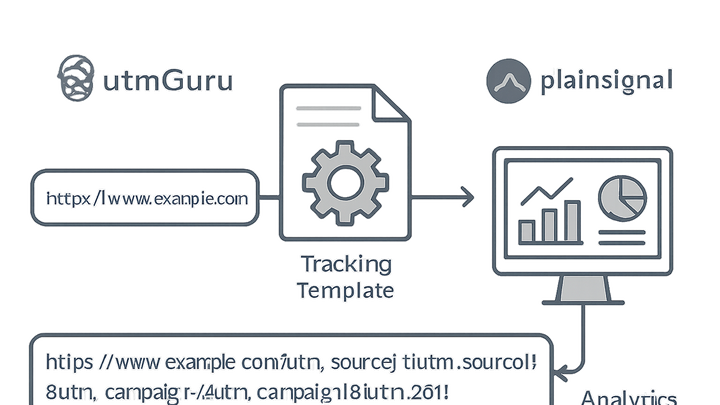Published on 2025-06-29T19:29:01Z
What is a Tracking Template? Examples and Best Practices
Tracking Templates allow marketers to define a reusable URL structure for campaigns that automatically
inserts tracking parameters. By using a centralized template, you ensure consistent application of
UTM parameters or ad-specific macros across multiple ads and channels. This reduces manual
errors, speeds up campaign setup, and improves attribution accuracy in analytics platforms such as
plainsignal or Google Analytics. Tools like utmGuru simplify the creation and management of templates with
placeholders like {{utm_source}}, {{utm_medium}}, and
{{utm_campaign}}, enforcing your naming conventions. Whether for paid search, social media,
or email marketing, Tracking Templates are key to scalable, reliable campaign tracking.
Tracking template
A preset URL structure automating campaign tracking parameter insertion for consistent, scalable analytics.
Why Tracking Templates Matter
Tracking Templates streamline campaign URL management, improving consistency and efficiency while reducing errors in tracking data.
-
Consistency across campaigns
Enforces uniform naming conventions and parameter usage to prevent discrepancies in analytics.
- Avoid manual typos:
Automatically insert parameters to eliminate human errors in URL tags.
- Standard naming:
Use predefined placeholders to maintain consistent parameter values.
- Avoid manual typos:
-
Scalability and efficiency
Bulk apply templates to multiple ads or campaigns, saving time in campaign setup.
- Bulk editing:
Update URLs en masse by modifying a single template.
- Version control:
Manage template versions to track changes over time.
- Bulk editing:
-
Improved attribution accuracy
Ensures that all traffic sources are tracked correctly for reliable performance data.
- Error reduction:
Minimizes missing or misattributed visits due to inconsistent URL tagging.
- Complete data capture:
Captures all predefined parameters for full attribution coverage.
- Error reduction:
Components of a Tracking Template
A Tracking Template comprises the base URL, a query string with placeholders for parameters, and optional conditional logic for dynamic insertion.
-
Base url
The root destination of the link, such as your landing page domain.
- Example:
-
Parameter placeholders
Dynamic tokens that your ad platform or UTM builder replaces with actual values at click time.
- Utm macros:
{{utm_source}},{{utm_medium}},{{utm_campaign}}for UTM-based tracking. - Ad platform macros:
{lpurl},{adgroupid},{keyword}in Google Ads templates.
- Utm macros:
-
Conditional logic (optional)
Rules to adjust parameters based on context, such as device or audience.
- Device-specific tags:
Add
{{device}}placeholder to capture mobile vs. desktop. - Custom conditions:
Use IF statements to apply parameters only when certain criteria are met.
- Device-specific tags:
Example: Building a Tracking Template with utmGuru
utmGuru provides an intuitive interface to generate and save UTM templates, which you can then integrate into ad platforms.
-
Generate utm parameters
Use utmGuru’s builder to select or input values for source, medium, campaign, term, and content.
- Select source:
Choose from predefined sources or enter a custom value.
- Define campaign:
Name your campaign according to your naming conventions.
- Select source:
-
Integrate into template
Insert the generated UTM string into your platform’s Tracking Template field.
- Google ads example:
Set your template to
{lpurl}?utm_source={{utm_source}}&utm_medium={{utm_medium}}&utm_campaign={{utm_campaign}}
- Google ads example:
-
Save and reuse
Save the template in utmGuru for consistent reuse across future campaigns.
- Template library:
Access and update saved templates directly within the utmGuru dashboard.
- Template library:
Integrating with plainsignal Analytics
After setting up your Tracking Template, add the PlainSignal analytics snippet to capture and analyze incoming parameters.
-
Add plainsignal script
Insert the PlainSignal script in your page
<head>section to enable cookie-free analytics.- Installation snippet:
<link rel='preconnect' href='//eu.plainsignal.com/' crossorigin /> <script defer data-do='yourwebsitedomain.com' data-id='0GQV1xmtzQQ' data-api='//eu.plainsignal.com' src='//cdn.plainsignal.com/plainsignal-min.js'></script>
- Installation snippet:
-
Verify parameter capture
Check your PlainSignal dashboard to ensure UTM parameters from the tracking template appear correctly.
- Real-time reports:
View incoming traffic with full parameter details in PlainSignal’s live analytics.
- Real-time reports:
